It’s a dirty business,’ notes Markus Lüpertz (b. 1941) as he steps over sheets of paper strewn across the wooden floor. The top one bears the image of a nude viewed from behind, and is dusted with dark footprints. His studio spans the top floor of an outbuilding on art dealer Michael Werner’s 50-acre estate near Berlin, and is littered with the tools of his trade, along with some altogether stranger items. A stuffed crocodile broods in a corner, its back turned to a flock of taxidermy birds roosting in the eaves. A soldier’s helmet rests on a table. Near the doorway, weights and a punching bag lie on the floor, beside a clothes rail packed with long dark coats and a pool table covered in men’s hats. The artist moved here permanently last year, abandoning a larger studio in Teltow after a burglary: it feels like there’s unpacking still to be done.
Immaculately dressed and carrying his signature black cane, the painter heads to the far end of the room past strange, mute gatherings of the rough-edged classical figures that populate his recent works. We stop in front of an easel painting of a muscular nude on a grassy bank. To his right are quiet waterways and trees: to his left, the scene disintegrates and a skeletal figure peers out, painted in a viscous black. ‘If you take away one layer of the world, you see its skeleton,’ Lüpertz suggests through our interpreter, when I ask about it. At this point Michael Werner interrupts. ‘Maybe it’s useful to tell you the ongoing struggle with interviewers and Markus Lüpertz,’ he says with a half-smile. ‘If he could explain a painting he wouldn’t paint it. You’re probably used to well-educated artists who are prepared to give you any answer you want […] He is not this type. He’s complicated.’
For Lüpertz to be anything else would be quite a surprise. For decades he has been an uncooperative force in the art world; a self-styled dandy in the postmodern age; a fervent champion of unfashionable painterly traditions, whose work nonetheless speaks directly to contemporary anxieties. His paintings are packed with recognisable subjects, yet he insists that art is abstract. So complicated – and overlooked – is his substantial oeuvre that when curators in Washington, D.C. began discussing his first US retrospective, they wound up staging two, at the Phillips Collection and the Hirshhorn Museum, both of which open this month.
There was never any doubt over Lüpertz’s calling. ‘Everything I know and everything I am comes from painting,’ he tells me. Born in Liberec (formerly Reichenberg), Bohemia, in 1941, the artist fled as a child with his family to West Germany’s Rhineland. As a teenager, he attended the School of Applied Arts in Krefeld, supplementing his studies with stints in construction work and mining. A truncated period at the Kunstakademie Düsseldorf and a short spell in Paris introduced him to art history’s methods and masterpieces, but it was only on moving to West Berlin in 1962 that he found an artistic community in which he would flourish. ‘Berlin was a dried-out city after the war, but it rose from the ashes,’ he reminisces, about a place that he now finds disappointingly bourgeois. ‘The bars always stayed open, there was work to find, and you could afford it.’ He fell in with the group of artists – Georg Baselitz, A.R. Penck, and Jörg Immendorff among them – that gathered around Werner (who opened his first gallery in 1963) and quickly emerged as a force to be reckoned with in German post-war art.
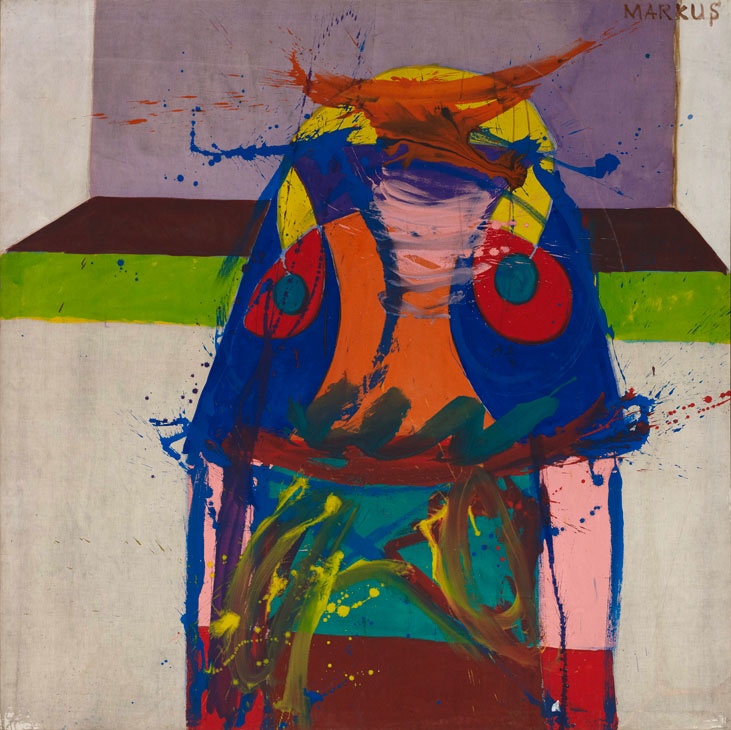
Donuald Ducks Hochzeit (Donald Duck’s Wedding) (1963), Markus Lüpertz. Courtesy Hall Art Foundation/© the artist
Performance and conceptual art, which was gaining a following around Joseph Beuys, did not interest Lüpertz professionally, but the prevailing currents of 1960s painting – Abstract Expressionism and Pop – dissatisfied the young painter, too. In an audacious early series, the Donald Duck paintings, he crashed both styles together. Donald’s cartoonish features are hopelessly confused in a medley of expressive brushstrokes – and yet his presence there at all renders the ostensibly abstract idiom absurd. The duck’s demise emphasised a problem recognised by many painters at the time – the supposed incompatibility of representational and abstract art. The former was treated with suspicion because it could be, and frequently was, put at the service of propaganda and populism; but abstract artists, Lüpertz believed, were labouring under a misapprehension. ‘Whenever you paint something abstract the eye leads you to search for a figurative element, and vice versa.’ There had to be some way to reintroduce the subject without detracting from the painting itself.
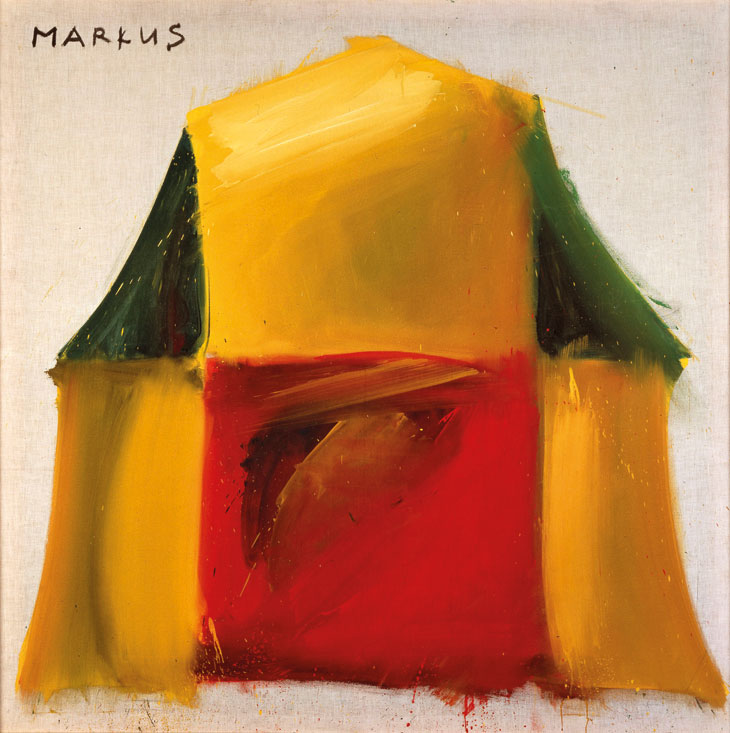
Diamant–dithyrambisch (Diamond–Dithyrambic) (1965), Markus Lüpertz. Courtesy Michael Werner Gallery, London and New York; © the artist
Lüpertz’s solution, and his first major contribution to contemporary art, was the ‘dithyramb’. Inspired by the fabled ecstatic chants of Dionysian revellers, he embarked on a series of paintings in which he worked obsessively over shapes and forms. In some cases, he built solid-looking, but nondescript objects intuitively out of patches of colour; in others, he worked in reverse, rehearsing and re-forming a simple motif until – like a word chanted too many times – it lost its original meaning. For one such series, Lüpertz took tents as his starting point. There can be no question over the ‘subject’ of the resulting paintings: canopies, poles, and canvas walls appear, in simple yet legible permutations, in every one. But their very obviousness transforms them. Subject matter established, the viewer can move on to notice the subtle illogicality of their shapes (many are as impossible as the architecture in medieval altarpieces), the intensity of their colours, the ambiguity of their contexts. The imagery acts as a way in to the painting, not a destination in itself – a tent pitched in the colour fields of abstract art.
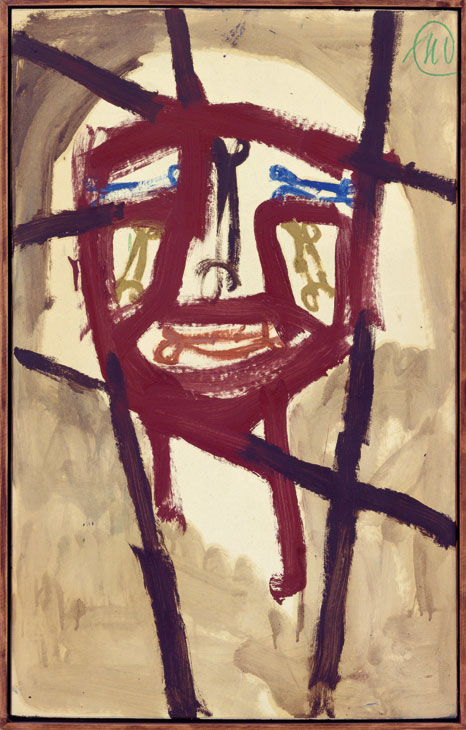
Manner ohne Frauen. Parsifal (Men without Women: Parsifal) (1993), Markus Lüpertz. Image courtesy the Phillips Collection
Perhaps the most sustained example of Lüpertz’s dithyrambic method is Men without Women (Parsifal) from the 1990s, a huge series of faces assembled from the sparest of pictorial elements – blocks of colour or networks of lines. It is impossible not to read their features as human, impossible not to see them as grids – and so we must hold both those possibilities in mind at once. ‘My generation lifted the dissonance between abstraction and figuration,’ Lüpertz explains of his breakthrough. ‘Both are possible […] That’s why we can paint so well today.’ He continues to work consistently and prolifically in series. Hundreds of drawings pave the way for dozens of paintings, each inflected by the last. The dithyrambs of the 1960s offered a promising modus operandi, which Lüpertz soon tested out on the most loaded subject imaginable at the time – Germany’s fascist past. His infamous German Motifs from the 1970s depict the uniforms and weaponry of Nazi aggression and the imperial symbols that glorified it. These were images whose significance was impossible to overlook – yet, true to his method, Lüpertz raked over and over them with the result that no particular message or moral could take root. In Sinking Helmets, the discarded combat gear presses grimly into muddy painted ground, the monumental scale matching the gravity of the subject. In Helmet II the object rests menacingly on top of an army jacket, while in Black-Red-Gold it balances on a Roman-looking breastplate and chariot wheels stuck in the rutted soil. Germany’s tricolour flag was banned by the Nazis in favour of the imperial black, red and white, and only reinstated after the war. While artistically these assemblages resemble De Chirico’s surreal classical monuments, emotionally they feel like phantoms or, more troublingly, grim resurrections of a still unburied past.
Lüpertz was not alone in his choice of subject. Baselitz had already painted his broken Heroes; Kiefer was soon to publish his Occupations series, for which he photographed himself giving the Nazi salute. Their decision to grapple with Germany’s recent past meant accepting the uncomfortable intimacy that such gestures entailed; inevitably the work proved controversial. ‘There were bohemians, and the establishment’ in Berlin at the time, Lüpertz recalls. ‘The establishment rejected the works because they didn’t know how to deal with the German motifs.’
These paintings have become no less inscrutable with age – just differently so, as the Hirshhorn’s ‘Threads of History’ exhibition, dedicated to his formative years, makes clear. ‘What’s interesting is how his paintings acquire different meanings through time,’ curator Evelyn Hankins comments, explaining how the ears of corn Lüpertz painted at the time, for example, have largely shed their connotations with the ‘Blood and Soil’ rhetoric of the Third Reich and will be understood differently in the US. The exhibition concludes with a set of paintings started soon after the German motif works and named after Babylon – a comparatively remote subject at the time, which this year will surely harbour new emotional charge in light of the destruction in Iraq. Hankins describes the Babylon paintings as ‘the beginning of a retreat into history’ for Lüpertz. But if their political implications were less prominent, artistically they signalled an important opening out of his work.
Over the decades, Lüpertz has painted motifs culled from sources as diverse as fashion advertising, Romantic landscapes, and cubist still lifes. He’s created bodies of work devoted to specific classical heroes, and a series of Arcadias, which pulls them – or the motifs and statuary by which we know them – together in verdant settings. He has quoted directly from old and modern masters, honouring some of them, such as Corot and Dürer, with series of their own. Some of these allusions have the visual irony of his Donald Ducks – in Sleep/Prometheus (After Poussin) from 1989, a reclining figure from the French painter’s Echo and Narcissus naps under a blanket seemingly made by Mondrian – but the gesture of recognition is sincere. ‘I live within painting, and painters who have passed away live on in their paintings,’ the artist tells me. ‘Their work is relevant to me – up to date. I am in discourse with the paintings from previous generations, from my contemporaries, and from the future.’
This sense of the timelessness of art, with nothing off limits to the contemporary painter, is important. Over series and in single compositions, Lüpertz accumulates familiar motifs with the effect of making them more abstract, more fluid. In this context, the German motifs, which he never completely abandoned and includes frequently in recent pictures, take their place among shells, statues and skulls as modern memento mori – the rawest signs of Western culture’s long cycle through periods of aspiration, civilisation, and destruction. ‘There is nothing new in painting. It is a discipline [that] we are working within,’ he tells me. ‘Painting regenerates through the input of new painters – that’s why it is vital. The quality of painting is a given. We all fail [to meet its] high demands. The key is to fail on higher grounds.’ Several times during our conversation, he alludes to painting as something divine, existing outside of time. By extension, the entire, evolving art-historical canon might be seen as one long dithyramb in its honour.
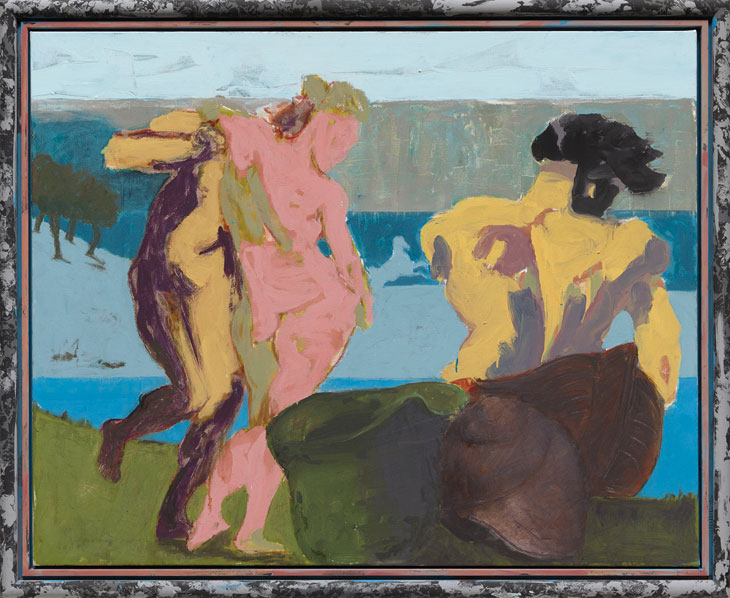
Arkadien – Der hohe Berg (Arcadia – The High Mountain) (2013), Markus Lüpertz Courtesy the Phillips Collection
For a man so staunchly committed to painting, Lüpertz has many creative side-lines. He’s a talented pianist (a C. Bechstein sits open in the studio’s anteroom), has worked on set designs, and since the 1970s has published his own poems. At the end of our meeting he hands me his latest book, Arkadien, illustrated with lithographs reminiscent of his paintings. When I ask whether he is tempted to experiment more with printmaking (his repetition of motifs, in different states each time, begs the question) he looks thoughtful. ‘I have only worked with it peripherally,’ he replies, ‘and it is still dependent on what I paint or sculpt. I’m in the process of developing a unique thematic for printmaking, to grant it independence within my oeuvre. My dream is Goya’s Disasters of War. It is the pinnacle of printmaking.’
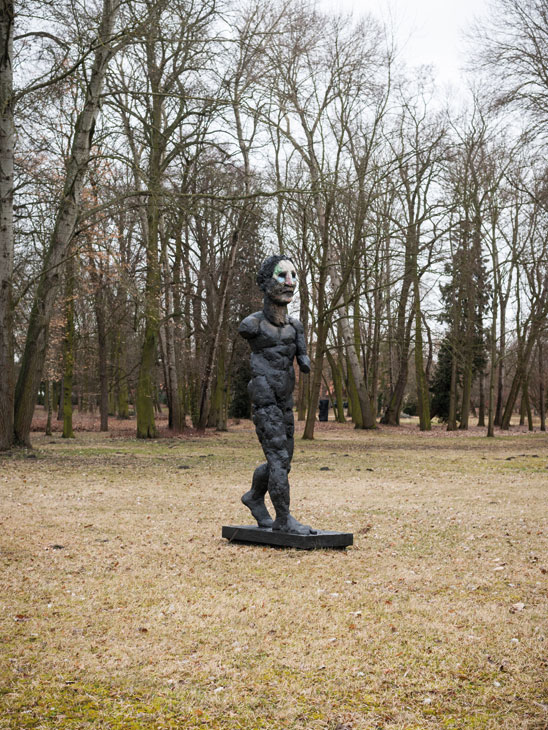
Achilles (2014), Markus Lüpertz, installed at Michael Werner’s estate outside Berlin. Photo: Thomas Meyer; courtesy Michael Werner Gallery, New York and London; © the artist
Of all Lüpertz’s creative offshoots, his sculpture is the most well known. He created his first works in 1981, ironically at a time when painting was enjoying a critical revival. (That year, Lüpertz participated in the Royal Academy’s ‘A New Spirit in Painting’ where his work inspired a young Peter Doig.) ‘I created a world with a horizon,’ he tells me of his decision to experiment in three dimensions. ‘This world and the horizon needed inhabitants.’ Several of his sculptures lope through the estate, looking for all the world like they’ve stepped out of one of his Arcadias. Among them is Achilles, seemingly based on Rodin’s fractured Walking Man. This armless, athletic figure is roughly put together; his surface pockmarked; his dark bronze face painted to recall war paint and court makeup simultaneously. Like his paintings, Lüpertz’s figurative sculptures fuse a jumble of art-historical tropes with surprising coherence and grace. They are foolish heroes, or heroic fools, whose damaged forms express the trauma of the 20th century while acknowledging heroism’s enduring appeal.
In 2005, Lüpertz created a monument to Mozart in Salzburg. Gerhard Richter called it a ‘depravation’ of art and a few disgruntled locals tarred and feathered it. ‘I am not interested in provocation: I am part of society’, he tells me when I ask about the controversies that have peppered his career. ‘If society does not agree with what it creates, it is society’s problem.’ Lüpertz is clear in his belief that people have a responsibility to cultivate themselves. In the literature accompanying his 2015 retrospective at Paris’s Musée d’Art Moderne, he spells it out: ‘Painting is an abstract product, and it is only through the viewer that it tells a story. Painting does not educate the person looking at it, it does not provide lessons, but it takes the viewer seriously and ennobles him by assuming an intellectually emancipated world.’ As dean of the Kunstakademie Düsseldorf – a post he held for 21 years until 2009 – he invited great artists not to teach, but to inspire, conceiving of the institution as a meeting place of receptive minds.
Is the next generation of artists up to the challenge? Lüpertz insists that there are great painters in every age, but perhaps the current one is not conducive to their success. ‘People are like puppets – always on their phones and computers,’ complains the painter, who owns neither. ‘Everything is controlled with little room for intelligence. But with the next war this will all be dealt with.’ It’s a provocative statement, particularly today, with nationalistic, racial and religious tensions on the rise around the world. I ask him what role artists should play in times of such uncertainty. ‘It’s not a problem for the artists, but a problem for all of us,’ he replies. ‘We must learn to live in peace, but up to today we have only managed to defend it. People are surprised by peace and degenerate the moment they achieve it. The degeneration is sold as freedom. And that freedom right now is very vague, because freedom demands intelligence and there is a world-wide shortage.’
At the end of our interview, Lüpertz is ushered downstairs by his studio manager, who wants him to make a few phone calls on the landline. I take the opportunity to look again at his work in light of all we’ve discussed. His classical heroes show the wear and tear of centuries – used to bolster one set of ideals, damaged or abandoned in society’s inevitable counter-movement – and the skeleton in the corner seems a fitting symbol of the violence underpinning it all. But then I look again. At the edge of one figure group, a yellow-painted grid lies visible on the surface. In another, a centaur’s human and animal halves are joined by a large block of black dots. ‘If you take away one layer of the world, you see its skeleton,’ Lüpertz said. But this is the world of painting, and its framework is different. There’s nothing to suggest Lüpertz will paint over his grids and leave the skeleton; nothing really to suggest he sees them differently at all. ‘I am curious about your interpretation, not my own,’ he tells me before I leave. ‘I can say something different every day.’
‘Markus Lüpertz: Threads of History’ is at the Hirshhorn Museum, Washington, D.C. from 24 May–10 September.
‘Markus Lüpertz’ is at the Phillips Collection, Washington, D.C. from 27 May–3 September.
From the May issue of Apollo. Preview and subscribe here.
Unlimited access from just $16 every 3 months
Subscribe to get unlimited and exclusive access to the top art stories, interviews and exhibition reviews.

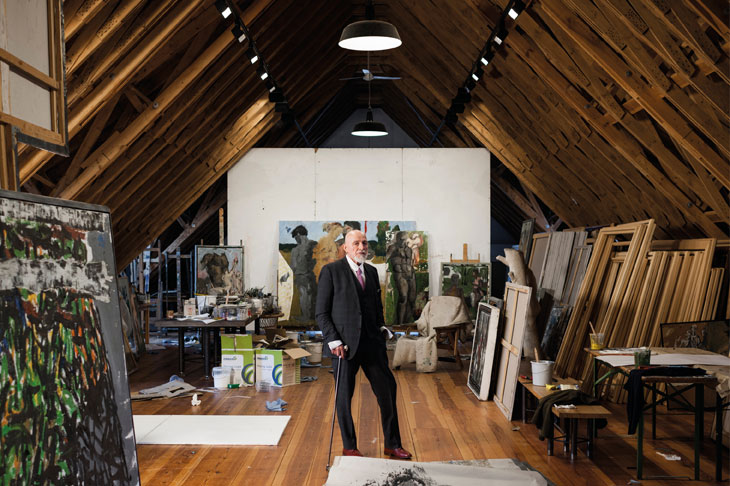









![Masterpiece [Re]discovery 2022. Photo: Ben Fisher Photography, courtesy of Masterpiece London](http://www.apollo-magazine.com/wp-content/uploads/2022/07/MPL2022_4263.jpg)
It’s time for the government of London to return to its rightful home